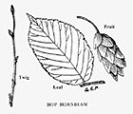AMERICAN HOPHORNBEAM
ironwood
Ostrya virginiana (Miller) Koch
|
American hophornbeam is closely related to the American hornbeam and is rather generally distributed throughout New York State on dry, gravelly, and stony soils of slopes and ridges, sometimes taking possession of woodlots in central New York to the exclusion of other species. The tree is slow-growing and is rarely found larger than 10 inches in diameter. The wood is very heavy, hard, and strong, hence the name "ironwood." It is used for tool and implement handles and for levers, and makes excellent fuelwood when seasoned. |
| Bark - thin, very markedly flaky; light grayish brown in color, broken into narrow, flattish pieces, loose at the ends.Twigs - fine, reddish brown in color, smooth, and shiny; a very easy winter character for identification of the tree, particularly of young saplings. Winter buds - terminal bud absent as in birches and elms; lateral buds small, light reddish brown in color, bending away from the twig. Leaves - alternate, simple ovate, 3 to 5 inches long, doubly and finely serrate on margin. Fruit - a small, seed-like nutlet, enclosed in an inflated, sac-like bract. Bracts - in clusters 1 to 2 inches long, resembling hops, hence the name "hophornbeam." Fruit usually falls before winter. Distinguishing features - shreddy bark; shiny, reddish-brown twigs; papery fruit like a hop. |

No comments:
Post a Comment